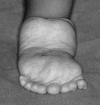Pre-axial mirror polydactyly associated with tibial deficiency: a study of the patterns of skeletal anomalies of the foot and leg
- PMID: 19308506
- PMCID: PMC2656696
- DOI: 10.1007/s11832-006-0001-5
Pre-axial mirror polydactyly associated with tibial deficiency: a study of the patterns of skeletal anomalies of the foot and leg
Abstract
Purpose: The study was undertaken to identify the patterns and spectrum of aberrant development of the skeletal elements of the leg and foot in children with pre-axial mirror polydactyly of the foot.
Methods: Case records and radiographs of eight children (ten feet) with pre-axial mirror polydactyly were studied. Four feet were seen in association with fibular dimelia, three feet with dysplastic trapezoid shaped tibia, two with tibial aplasia and one with tibial hypoplasia.
Results: Distinct patterns of anomalies of the hindfoot, midfoot and forefoot were noted, with different patterns of leg malformation. Fibular dimelia was associated with duplication of the calcaneum, cuboid and the lateral cuneiform. Talar duplication occurred in children with a trapezoidal tibia. No duplication of tarsal bones was seen in association with tibial aplasia or hypoplasia. The first metatarsal was hypoplastic wherever the tibia failed to develop. Mere resection of the supernumerary rays resulted in a near normal looking foot in feet without calcaneal duplication. The cosmetic appearance of the foot was poorest in children with fibular dimelia.
Figures






References
-
- Igou RA, Kruger LM. Fibular dimelia in association with proximal focal femoral deficiency, tibial deficiency, and polydactyly. Clin Orthop. 1990;258:237–241. - PubMed
LinkOut - more resources
Full Text Sources

